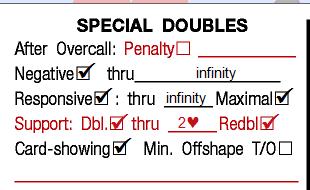Doubles

All details of doubles discussed in this section can be found here (you will find "Takeout Doubles" in the list -- though I wouldn't consider it a "SPECIAL DOUBLE" -- it is just part of normal bidding and something all players need to be thoroughly acquainted with.)
Negative doubles are played through infinity. After any overcall, responder cannot make a penalty double (he can pass and hope opener doubles for takeout, and then he can leave it in).
Responsive doubles are also played through every level. They are used if the opponents bid and raise, or if they bid two different suits. (Example: 1 X 1
X 1 X = cards -- not penalty). [In this case, 2
X = cards -- not penalty). [In this case, 2 would be natural.] This is just in keeping with the general policy of "no" penalty doubles on the 1- or 2-level.
would be natural.] This is just in keeping with the general policy of "no" penalty doubles on the 1- or 2-level.
Maximal Doubles (Game try doubles) are played if we open (or overcall) and responder raises our major, and the opponents bid the suit exactly below our suit on the 3 level (Example: 1 P 2
P 2 3
3 X is a game try, and 3
X is a game try, and 3 is to play).
is to play).
Support Doubles (and Redoubles) are played through 2-of-our suit. They are on no matter what suit we respond in (on the one level). If the opponents overcall 1NT, they are still on. They are on by a passed hand. They are on even if our responder promised a 5-card suit (such as: 1 [1
[1 ] 1
] 1 ). If the opponents bid 2 of our suit (or higher), the double is just card-showing. If they actually bid our suit (1
). If the opponents bid 2 of our suit (or higher), the double is just card-showing. If they actually bid our suit (1 -P-1
-P-1 -2
-2 ), then double just shows extra values.
), then double just shows extra values.
Card-showing doubles is another way to say DSI (Do Something Intelligent). In general, unless there is a partnership rule stating that a double is for penalties, then it isn't for penalties.
For a full LC Standard card and a prettier version of this series, see Bridge Winners.
You might also consider getting Larry's book on Doubles and Redoubles HERE or try Michael's Doubles Webinar which you can find HERE.
Recommended reading: Doubles
Also: What Should we Play?